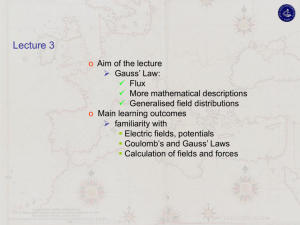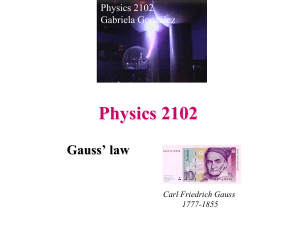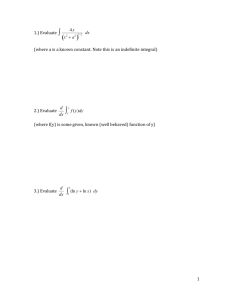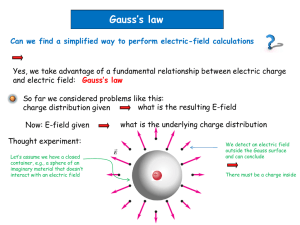electric flux - e-CTLT
advertisement
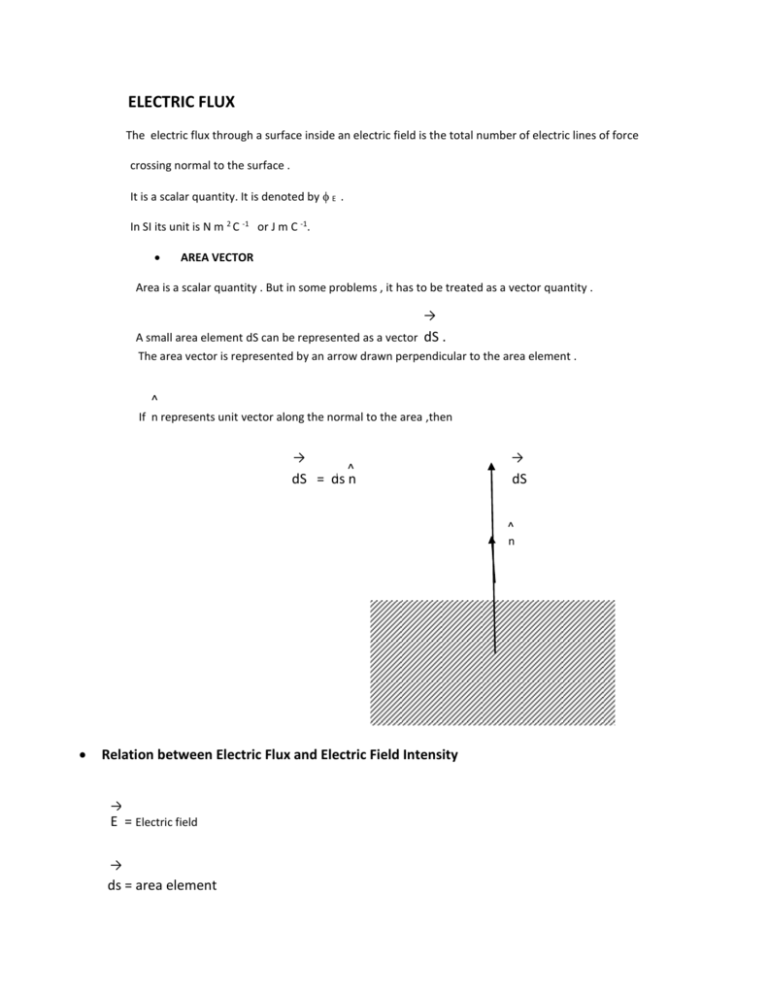
ELECTRIC FLUX The electric flux through a surface inside an electric field is the total number of electric lines of force crossing normal to the surface . It is a scalar quantity. It is denoted by E . In SI its unit is N m 2 C -1 or J m C -1. AREA VECTOR Area is a scalar quantity . But in some problems , it has to be treated as a vector quantity . → A small area element dS can be represented as a vector dS . The area vector is represented by an arrow drawn perpendicular to the area element . ^ If n represents unit vector along the normal to the area ,then → ^ dS = ds n → dS ^ n Relation between Electric Flux and Electric Field Intensity → E = Electric field → ds = area element → E dS → ѳ E E → E d E = E . dS d E = E . dS Cos ѳ (1) The total electric flux over a closed surface is E = E. d s = ∫ E dS Special cases (i) When ѳ > 90 0 , E = - ve (ii) When ѳ = 90 0 , E = 0 (iii) When ѳ < 90 0 , E = + ve GAUSS’S THEOREM The electric flux of an electric field E through an arbitrary closed surface S is equal to 1/0 times the total charge enclosed by the surface. qin E . ds 0 The hypothetical closed surface is called Gaussian Surface . Proof of Gauss’s Theorem for spherically symmetric surfaces → = E. ds E r = ∫ 𝐸𝑑𝑆𝑐𝑜𝑠 ѳ O = E ∫ 𝑑𝑠 dS 𝑑 E 𝑆 q 1 ⟹ = E 4r2 → And E = 1 𝑞 4𝜋𝜀𝑂 𝑟2 1 E = 4𝜋𝜀𝑂 𝑟^ 𝑞 2 𝑟2 From equations 1 & 2 , we have = q E. d s 3 0 Deduction of Coulomb’s Laws From Gauss’s Theorem q E . d s 0 (1) = E. ds ∫ 𝐸𝑑𝑆𝑐𝑜𝑠 ѳ = And 0 q = ∫ 𝐸𝑑𝑆 = E ∫ 𝑑𝑆 = E 4r 2 From equations 1 & 2 , we have (2) 1 E = 4𝜋𝜀𝑂 𝑞 𝑟2 ( 3) E=F/q0 1 F = 4𝜋𝜀𝑂 𝑞 𝑟2 q0 Significance of Gauss’s Theorem ( 4) r → dS → E 1. Gauss’s law is to calculate electric intensity for different geometrical shape bodies containing charges inside its. 2. It can be also used to calculate the charge inside the surface. 3. It helps to get the properties of conductors. Assignments 1. Calculate the number of electric lines of force originating from 1 C charge . E = q / 0 = 8.6 X 105 N m 2 C -1 2.What is the electric flux through the surface S in Vaccum? E = q / 0 3. If = 3 +4 -5 , calculate the electric flux through a surface of area 50 units in z-x plane Ans: 200 unit 4. Name the physical quantities whose SI units are Vm, Vm-1. Which of these are vectors? Ans: Vm → electric flux, scalar ; Vm-1 →electric field, vector 5. A point charge + 10 C is at a distance 0.05 m directly above the centre of a square of side 0.10 m as shown in the figure. What is the magnitude of electric flux ? 0.05 m 0.10m 0.10 m . 2. Ans 1.The given square can be imagined as one of the six faces of a cube of side 0.10 m. 3. ∴ ϵ0 = 1.88 X 105 N m2 C - 1 5. . 6. 7. 8. 9. 10. Define electric flux . Write its SI unit . Whether it is a scalar or vector quantity ? State and prove Gauss’s Theorem . Deduce Coulomb’s Laws from Gauss’s Theorem . What are the importance of Gauss’s Theorem ? S 1 and S 2 are two hollow concentric spheres enclosing charges 2Q and 4Q respectively as shown in the figure. S2 4Q 2Q S1 (i) (ii) What is the ratio of the electric flux through S 1 and S 2 ? How will the electric flux through S 1 and S 2 change , if a medium of dielectric constant 6 is introduced In the space inside S 1 in place of air ? Application of Gauss’s Theorem To find the electric intensity at a point due to a infinitely long Straight charged conductor. To find the electric intensity at a point due to uniformly charged infinite plane sheet . To find the electric intensity due to two uniformly charged plane sheet . To find the electric intensity at a point due to uniformly charged thin spherical Shell or hollow sphere. To find the electric intensity at a point due to uniformly charged non conducting solid sphere. Electric intensity at a point due to a infinitely long Straight charged conductor An imaginary cylinder is drawn with radius r and length l is drawn. + → r l dS + dS + From Gauss’s Theorem = And = q E . ds 0 E . ds (i) ∫ 𝐸𝑑𝑆𝑐𝑜𝑠 ѳ = ∫ 𝐸𝑑𝑆 = E ∫ 𝑑𝑆 ⟹ = E 2r l (ii) From equations (i) & (ii) , we have q E 2r l = 0 1 ⟹ E = 2𝜋𝜖0 𝑞/𝑟 𝑙 = → ⟹ E = 1 𝜆/𝑟 2𝜋𝜖0 1 𝜆/𝑟 2𝜋𝜖0 ^ r (iii) → E



